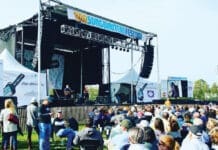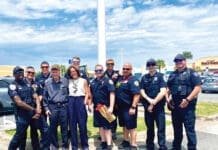Be Prepared. Stay Calm. Think Clearly. Act Quickly.
Tornadoes are nature’s most violent storms with furiously rotating columns of air extending from the base of a thunderstorm down to the ground. And those in our area can come upon us fast. They can occur at any time of the year day or night, and are capable of completely destroying well-made structures, uprooting trees and hurling objects through the air like deadly missiles. Advance preparation and recognizing emergency alerts are vitally important.
It seems we are seeing more in our area lately. Following an EF-1 tornado that spun through Miramar Beach in June and a prior EF-2 occurring in January, SoWal Connections wants to convey the importance of emergency alert systems and how to be prepared.
 Officials say Okaloosa County relies primarily on smartphone technology and emergency alert systems to warn people about severe weather notifications electronically. In the event of an emergency, electronic alerts are sent to your smartphone to notify you about impending severe weather. With the exception of Eglin Air Force Base and Hurlburt Field, there are no tornado sirens in Okaloosa County. If you’ve moved here from another area or state that has sirens, you might have wondered why and there are several reasons:
Officials say Okaloosa County relies primarily on smartphone technology and emergency alert systems to warn people about severe weather notifications electronically. In the event of an emergency, electronic alerts are sent to your smartphone to notify you about impending severe weather. With the exception of Eglin Air Force Base and Hurlburt Field, there are no tornado sirens in Okaloosa County. If you’ve moved here from another area or state that has sirens, you might have wondered why and there are several reasons:
• A siren provides only one warning and doesn’t specify the type of emergency, nor does it provide information on the recommended course of action you should take.
• In many places, Okaloosa County has buildings that are hurricane-proof, with thick concrete walls and roofs; sirens would be ineffective to transmit sounds through heavy materials.
• The emergency alert system uses current technology and cellphone towers to pinpoint and alert people in our local area. Whenever you start to see storm clouds closing in, keep your phone handy and ready to receive those alerts if necessary.
If you haven’t already, make sure you familiarize yourself with terms used to identify a tornado hazard.
A tornado watch means weather conditions are favorable for tornadoes to develop and are possible in your area. Monitor NOAA Weather Radio, commercial radio or television for the latest weather forecasts, or download a weather app. Even blowing debris or the sound of an approaching tornado may alert you.
A tornado warning means either a tornado has been sighted or detected by radar, IS already occurring or expected to develop shortly in your area (such as a funnel cloud rotation), and you need to take shelter or move to your pre-designated place of safety immediately; there is imminent danger to life and property to those in the path of the storm.
Some tornadoes develop without warning and oftentimes can be hidden by trees or rain. Be prepared to act quickly. Planning and practicing specifically how and where you take shelter is a matter of survival. Have a family communications plan, especially for when family members might be in different places. Keep a Ready Kit for at least three days of self-sufficiency.
Storm cellars or basements provide the best protection. If underground shelter is not available, an interior room or hallway on the lowest floor is the best option. In a high-rise building, go to a small interior room or hallway on the lowest floor possible. If you are in a mobile home, consider moving to a sturdy building (shelter). If a tornado warning is issued, you will not have much time to act.
 When a tornado warning is issued, put on sturdy shoes and go to a safe place and protect yourself from glass and other flying objects. If you are outside, hurry to a safe place in a nearby sturdy building. If you are in a car and you see large objects flying past while you are driving, pull over and park. You now have two choices:
When a tornado warning is issued, put on sturdy shoes and go to a safe place and protect yourself from glass and other flying objects. If you are outside, hurry to a safe place in a nearby sturdy building. If you are in a car and you see large objects flying past while you are driving, pull over and park. You now have two choices:
- Stay in the car with the seat belt on. Put your head down below the windows, covering with your hands and a blanket if possible.
- If you can safely get noticeably lower than the level of the roadway, in a deep ditch for instance, exit your car and lie in that area, covering your head with your hands.
If you live in an apartment or condo that is on an upper floor, get to the lowest level of the building.After a tornado, local authorities may not immediately be able to provide information on what is happening and what you should do. Listen to NOAA Weather Radio, watch TV, listen to the radio or check the Internet often for official news and instructions as they become available. Remain out of damaged buildings and stay clear of downed power lines. Report downed lines to your local power company. If you are trained, help injured or trapped people. Check on others who might require special assistance, such as the elderly, children and people with disabilities.





























































